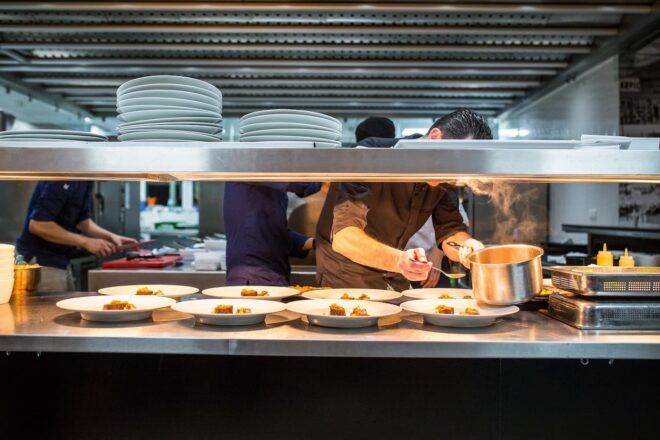Restaurant marketing strategies to grow your business
Editorial Team
11 min read
For restaurant professionals, there are many ways to grow your business, from bringing in a steadier flow of customers, to increasing order sales, to expanding to other locations. If you’re interested in boosting your business, strategic restaurant marketing can increase awareness for your brand and help you build deeper loyalty with current customers.
While food, drink, and service quality matters for restaurant success, so does spreading the word about your business. The following are some marketing, customer retention, and strategic partnership strategies to consider for increasing your restaurant business.
Effective restaurant marketing strategies
When marketing your restaurant, you first need to understand your unique selling proposition (USP) so that you can position your brand effectively in the market and stand out among competitors. To create a USP, think about:
- Who your target customer is
- The services and products you’re offering
- How your services and products benefit customers and/or solve customer pain points
- What makes you different from competitors in your space
When you analyze the answers to these questions, that can help inform the words, images, and tone you use in your marketing materials. With a USP, you can create brand guidelines for marketing elements like copy, color, design, and imagery that reflect your brand and help you create consistent branding across all platforms.
Digital marketing strategies for restaurants
Most restaurant customers today discover new brands online. According to a December 2022 study by GWI, the top way global internet users found out about new brands and products was search engines, cited by 31% of users. Word-of-mouth recommendations from friends or family members (including on digital sites), ads seen on social media, and brand/product websites also landed in the top five.
People spend a lot of time online; as DataReportal reports, global internet users spent 6 hours and 37 minutes online each day in the first quarter of 2023. That is a lot of potential to reach new customers and engage with current ones. Some digital marketing platforms your business can consider include:
- Social media: Social media marketing sites like Facebook and Instagram give your restaurant the opportunity to post food and drink photos, announce menu changes and specials, offer coupon codes, and more. Free social media sites can super-charge your digital marketing efforts, as users post about your restaurant and share content with their own networks. You can also purchase ads and use analytics on social media to gain more insights about which content performs the best, and which demographics are most likely to respond to your content.
- User-friendly website: When you drive customers to your website through social media platforms, search engines, or other websites, you’ll want to deliver an exceptional customer experience that keeps users engaged on your website. To make a user-friendly website, make sure it’s easily navigable on all devices; as Statista reports, people spend the majority of their online time using smartphones. Think about the customer journey you want to take website visitors on. Work with a user experience (UX) designer to create a website flow that provides value to users and gets them to interact with your business.
- Email marketing: Your restaurant can also use email marketing campaigns to engage leads and customers. According to Digital Agency Network, email marketing is up to 40 times more effective than social media when done right and can provide a return on investment of $39 for every $1 spent. You can collect customer emails both during purchases and on your website with a subscription box. You can use email to promote your offerings, send personalized coupons, share news, and more.
In addition to these digital marketing techniques, you can use a customer relationship management (CRM) system to gain deeper insights into your customers. As customers share their data with you through their purchases or by subscribing to an email list on your website, you can see how they interact with your business. CRM data helps you understand what products and services matter most to which customers, which can shape your business strategy.
Harnessing the potential of online reviews and ratings
Online reviews heavily influence dining decisions, especially when users are searching for restaurants in a particular area or for a particular type of cuisine. According to “Search Engine Journal,” 49% of consumers trust reviews as much as they do personal recommendations from family and friends.
You can gain more reviews by managing listings for your restaurant on sites like Yelp, Tripadvisor, Google reviews, and OpenTable. When you respond to reviews professionally, you show all customers you care about hearing their feedback and are grateful they shared. That can encourage more positive customer feedback.
You can also gain more happy reviews by mentioning your review sites to satisfied diners. You can promote review site links in email marketing, on social media, on your website, and in other marketing channels.
Customer retention best practices
Another way to grow your business is by strengthening the relationships with your customers so they become loyal, repeat diners. You can create a customer loyalty program that rewards diners the more they spend with you. For example, you can provide points per dollar spent that go towards a cash-off reward.
You can also focus on creating personalized experiences by providing rewards and offers based on customer preferences. For example, if a customer tends to order the same meal from you online, you could send a coupon for that menu item for next time.
Personalization pays off, as research from McKinsey & Company shows that personalization drives up to a 15% revenue lift. What’s more, while 71% of consumers expect personalized experiences from businesses, 76% of consumers get frustrated when this doesn’t happen.
When you offer personalized rewards based on customer preferences, you deliver greater value to consumers. This can help you increase loyalty and repeat sales for your restaurant.
Training a top-notch staff
Another key part of customer retention takes place during the actual dining experience. Your staff is responsible for delivering excellent customer service from the moment diners walk in the door, to when they leave.
If you have prior industry experience, you’re probably familiar with what makes great service for customers: a warm and welcoming greeting, educating customers about the menu, delivering accurate orders, and being as efficient as possible. As your business gains regular customers, you can start to learn guests’ names and preferences and create an even better, more personalized experience for every guest.
Listening to customer feedback
One of the best small business tips to improve customer retention is to listen to and implement customer feedback. To learn what matters to your customers, you can:
- Provide a survey link on receipts, and consider adding a random drawing prize for those who provide feedback
- Add a way for website visitors to submit feedback
- Pay attention to customer reviews online
When customers post feedback publicly (on an online review site, for example), your restaurant’s response could influence public opinion. Showing gratitude and noting that you’re listening and considering their feedback can motivate other users to leave feedback, too. It can also help create the perception that you’re a business that cares about customers, which could also result in more new customers trying your restaurant.
Leveraging restaurant partnerships
When you’re considering how to grow your restaurant business, collaborating with other businesses can help. Some ideas include:
- Run co-promotions with local businesses: Reach out to other businesses in your area to see if there are partnership opportunities. For example, you might leave coupons or cards for each other’s businesses when you drop off a check. Or, you could create a weeklong dining event where all participating restaurants offer discounts and promote each other in the restaurants and on marketing channels, like social media.
- Partner with food delivery platforms: The online food delivery market is exponentially growing, with Statista reporting a projected compound annual growth rate of 12.78% in revenue through 2027. You can capitalize on these opportunities by signing up for delivery platforms like Uber Eats and DoorDash. Through these platforms, you can offer special promotions, access analytics that show you what your most loyal customers are ordering, and give at-home diners a taste of your restaurant that might result in repeat orders or a visit to your location.
- Get involved in the local food scene: Many cities throughout the country host restaurant weeks and special dining events. Network with local event promoters to see what’s available to your restaurant. Sites like Yelp also host “Elite” events where power users can attend insider events. By participating in other branded events, you can expand the reach of your restaurant.
Think about your target customer base and where they spend their time besides your restaurant. This can provide you with ideas for collaborative marketing initiatives to explore.
Sourcing sustainable and local ingredients
The vendors you source from can also provide additional marketing opportunities. When you look for local vendors, you might attract people who are fans of the other brands.
For example, using bread from a local baker could impress diners who are also fans of that bakery. Eco-conscious customers may be interested in ingredients that are sustainable and locally sourced, too. You can name the other businesses you source from on your menu, which reinforces that your restaurant supports local and sustainable businesses.
Strategic alliances with complementary businesses
There may be other non-restaurant businesses that could prove to be beneficial partners for your restaurant. For example, a vegan restaurant might choose to host vegan-focused events and workshops.
Consider your restaurant’s values and mission, then look for like-minded businesses that could provide mutually beneficial cross-promotions. It might be your business providing catering for an event space, setting up a booth with take-home products at a farmers market, or hosting a local group to meet in your dining room.
Data-driven decision making
To grow faster, smarter, and more efficiently, restaurants should be tracking sales and customer behavior to gain insight into dining trends. Data tracking can help you optimize your supply orders and keep inventory costs lower. It can also help you learn which items are most popular with diners and which aren’t selling as well, so you can integrate those in promotions, upselling training, and menu changes.
With the right POS system, you can set, track, and analyze key performance indicators (KPIs). These might include:
- Total sales
- Price per ticket
- Category sales (drinks, appetizers, desserts, etc.)
- Business revenue
Research shows data-driven companies have better financial performance, are more innovative, are more likely to survive, and outperform competitors by up to 20%. You can gain an advantage over competitors that don’t use data to inform restaurant strategy by paying attention to your KPI performance and adjusting your restaurant strategies to improve them.
Utilizing technology for insights
You can use technology like the best restaurant POS systems to gather data and provide insight analysis for your business, right from the moment you open a restaurant. With a POS that includes CRM software, you can:
- Track every category of sales
- Sign up customers for loyalty programs that enable them to earn discounts and perks
- Create a personalized communication loop with customers
- Drive traffic with real-time promotions
- See what your most loyal customers are ordering the most
With insights all in one place, it’s easier to make connections among your data and get a clearer view of your restaurant success. As each customer orders with your restaurant, you’re able to gain more insights that can help your restaurant succeed.
Making informed decisions based on data
Using restaurant insights from your POS, you can further drive restaurant strategy, from how you train your servers, to the items you add to your menu. You can use your data to:
- Implement menu adjustments, including creating prix fixe menus, changing prices, and offering promotions
- Make operational improvements, such as optimizing your inventory and supply chain management
- Improve marketing efforts, using customer data to optimize campaigns and more accurately target customers
If you work with other partners, like a marketing consultant or website designer, you can share your restaurant data with them so they have a better understanding of your demographics and their preferences as well.
Growing your business with the right restaurant POS system
The recipe for restaurant success involves knowing your customers and how to engage them. The right marketing techniques can help you build loyal relationships with customers, allowing you to grow your business with them, gain more referrals, and attract more new customers.
To succeed in the fast-moving restaurant industry, it helps to learn about new technology and marketing strategies that can speak to your customer base. Clover POS, one of the best POS for restaurants, can help you streamline business processes and build better relationships with customers. Clover restaurant POS systems include CRM software, customer engagement features, data collection, and other helpful features that can help your business grow.
Why wait? Get started with a Clover restaurant POS system today.
Related Posts
Fiserv deepens Clover and BentoBox integration to unify restaurant operations
Get to know your clientele with Customers and Promos
Popular Topics
Stay in touch
Sign up and learn more about Clover.
Thank you for your subscription!
More posts about starting a small business
eBook
Retail roadmap: Financial goal-setting for the year ahead
Please share your contact information
to access our premium content.
Thank you for sharing your contact information.
Download Now





